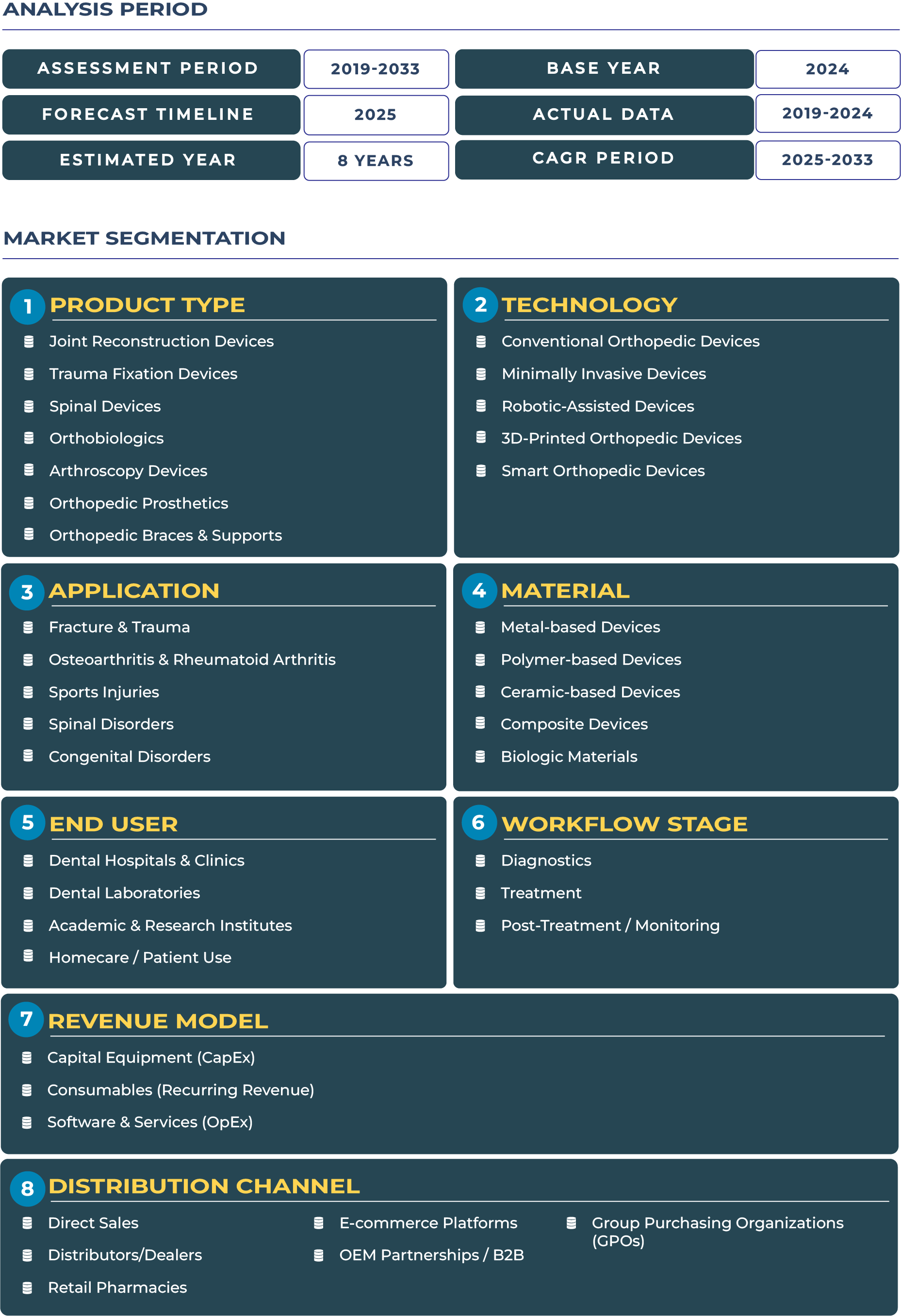Report Format:
![]()
![]() |
Pages: 110+
|
Pages: 110+
Thailand Orthopedic Devices Market Outlook: Thailand’s Universal Healthcare Driving Orthopedic Device Adoption Nationwide
Thailand Orthopedic Devices market is being shaped by one of the most important healthcare reforms in the region—its universal healthcare program. By offering broad access to essential medical care, the Thai government has created a platform for affordable mass adoption of advanced orthopedic treatments, from joint reconstruction to spinal interventions. With medical tourism and domestic demand converging, Thailand has emerged as a strong contender in Southeast Asia Orthopedic Devices landscape. In 2025, the Thailand orthopedic devices market is projected at USD 749.2 million, expected to expand to USD 1,516.1 million by 2033 at a CAGR of 9.2%. This robust growth is fueled by an expanding middle-class population, rising orthopedic disease burden, and greater access to trauma fixation and arthroscopy procedures under the universal healthcare umbrella. As Thailand continues to position itself as a global medical tourism hub, the orthopedic devices sector will play an increasingly strategic role in strengthening its healthcare competitiveness.
Thailand’s Expanding Orthopedic Ecosystem Driven by Public Programs and Private Partnerships
The outlook for Thailand Orthopedic Devices sector highlights a unique balance of government-led inclusivity and private sector innovation. Universal healthcare, administered by the Ministry of Public Health Thailand, ensures a baseline demand for essential orthopedic procedures across urban and provincial hospitals. Simultaneously, Thailand’s thriving private hospital ecosystem, particularly in Bangkok, Chiang Mai, and Phuket, has accelerated adoption of advanced devices such as biologics and customized prosthetics that cater to medical tourists and affluent patients. Thailand Orthopedic Devices industry also benefits from global manufacturing linkages, as medical device companies increasingly explore Thailand as a cost-efficient production hub. Despite geopolitical and supply chain disruptions in Asia, Thailand’s stable economic environment and government incentives for medtech development provide resilience to the orthopedic devices ecosystem. The sector’s medium- to long-term outlook reflects a market capable of serving both mass adoption under public healthcare and high-value demand from international patients.
Drivers & Restraints: Key Catalysts and Challenges Defining Thailand Orthopedic Devices Market
Drivers: Strong Tourism, Expanding Insurance, and Rising Private Investment
Thailand Orthopedic Devices industry is driven by three key pillars. First, its robust medical tourism sector, attracting over a million international patients annually, positions orthopedic care as a key specialty. Tourists from neighboring countries and Western markets often seek elective procedures such as knee replacements or arthroscopic surgeries in Thailand due to affordability and world-class expertise. Second, expanding private hospitals have created new demand centers for premium spinal and joint reconstruction devices, particularly in Bangkok and Phuket. Third, insurance penetration is improving steadily, with more Thais accessing coverage for advanced orthopedic interventions, boosting long-term demand for trauma fixation devices and orthobiologics. Together, these drivers strengthen Thailand Orthopedic Devices market outlook as both inclusive and premium-oriented.
Restraints: Regional Gaps, Pricing Pressures, and Infrastructure Challenges
Despite promising growth, the orthopedic devices sector faces restraints that temper its expansion. Regional inequality in access persists, as urban centers like Bangkok and Chiang Mai enjoy better-equipped hospitals, while rural provinces struggle with limited orthopedic specialists and logistics constraints. Price sensitivity also remains a challenge, particularly for prosthetics and advanced implants, as universal healthcare reimbursements prioritize affordability over premium adoption. In addition, logistics to Thailand’s numerous islands and remote provinces hinder consistent device distribution and service delivery. These structural barriers underline the need for strategic partnerships between government bodies and private players to ensure equitable growth across the orthopedic devices industry.
Trends & Opportunities: Orthopedic Devices Sector Positioned for Tourism-Linked and Localized Growth
Trends: Medical Tourism Revival and Day Surgery Expansion
The rebound of medical tourism is a defining trend shaping Thailand Orthopedic Devices ecosystem. Orthopedic surgeries, particularly hip and knee replacements, are bundled into international care packages that combine treatment with recovery-friendly tourism experiences. Private chains are also expanding aggressively in major cities, fueling uptake of trauma fixation devices and biologics. Another notable trend is the rise of ambulatory and day surgery centers in Bangkok and Phuket, which increasingly rely on minimally invasive devices such as arthroscopy tools for faster recovery and patient turnover. These shifts are modernizing Thailand Orthopedic Devices sector and aligning it with global best practices.
Opportunities: Partnerships, Tiered Pricing, and Integrated Packages
The Thai orthopedic devices market offers significant opportunities for innovative business models. Tourism and elective orthopedic packages remain a high-potential avenue, as hospitals and device manufacturers collaborate to attract international patients with bundled offerings. Partnerships with private chains create further opportunity for multinational orthopedic device companies to expand access to premium prosthetics and spinal systems. Additionally, tiered pricing models—where basic implants serve universal healthcare patients while premium devices target medical tourists—enable balanced growth. Such strategies reinforce Thailand’s competitive edge in delivering both accessibility and innovation in orthopedic care.
Competitive Landscape: Global Players and Thai Providers Strengthening Market Depth
The competitive dynamics of Thailand Orthopedic Devices market are shaped by the presence of global leaders such as Johnson & Johnson MedTech, Zimmer Biomet, and Stryker, alongside strong private hospital groups like Bangkok Dusit Medical Services (BDMS) and Bumrungrad International. Multinational companies increasingly use Thailand as a showcase hub for medical tourism-linked orthopedic devices, offering affordable product lines to cater to both domestic patients and international clientele. Local hospitals, meanwhile, are building partnerships with manufacturers to introduce tiered pricing strategies that enhance affordability while maintaining innovation. With initiatives such as surgeon training programs and device demonstration centers, Thailand Orthopedic Devices ecosystem is creating long-term foundations for sustainable growth. The market’s competitiveness is further reinforced by government-backed healthcare investments and Thailand’s global standing as a trusted medical tourism destination.







